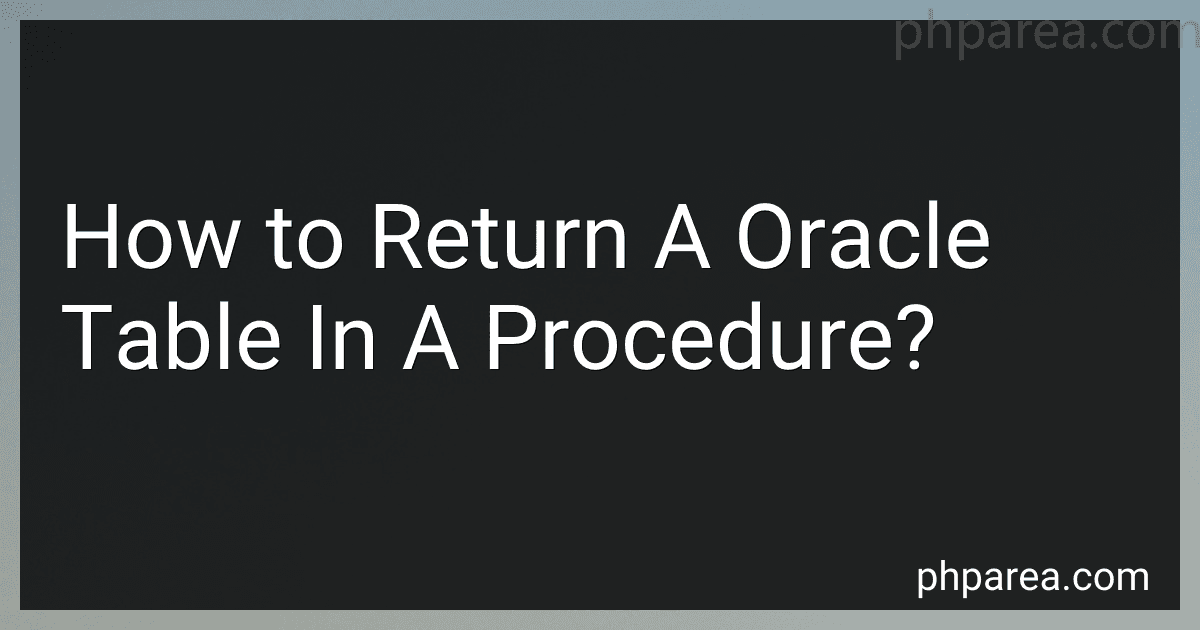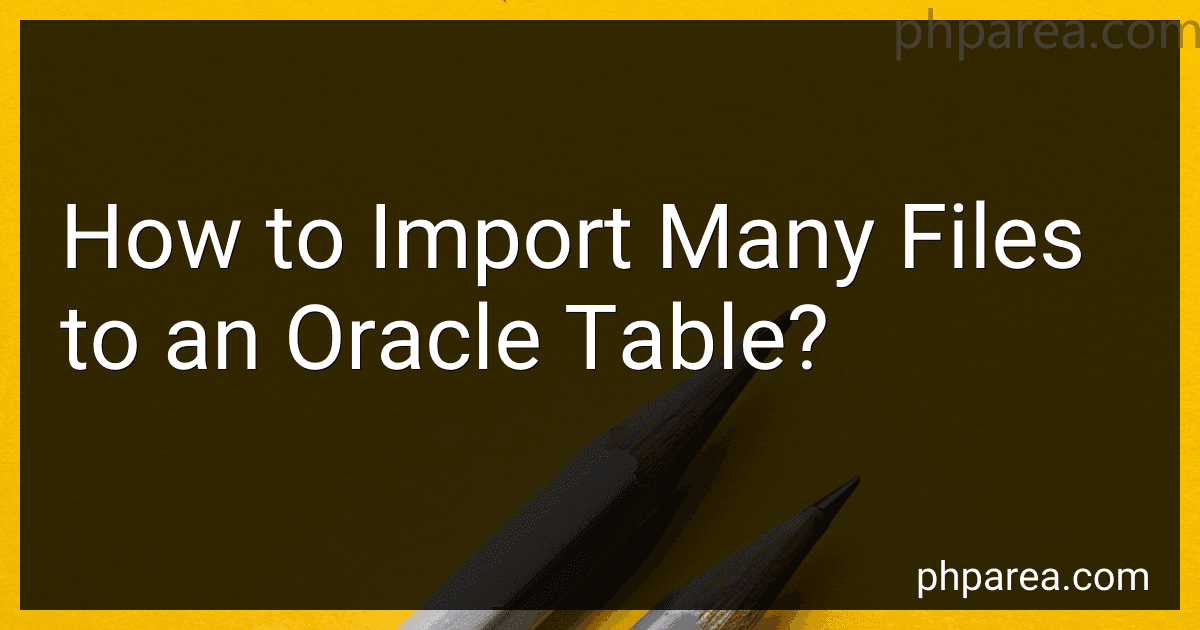PHP Blog
-
 7 min readTo get data from an Oracle SQL dump file, you can use the Oracle Data Pump utility. This utility allows you to import data from a dump file into your Oracle database. You can use the impdp command to import data from the dump file.First, you will need to have access to an Oracle database and have the necessary privileges to import data. You will also need the dump file that contains the data you want to import.
7 min readTo get data from an Oracle SQL dump file, you can use the Oracle Data Pump utility. This utility allows you to import data from a dump file into your Oracle database. You can use the impdp command to import data from the dump file.First, you will need to have access to an Oracle database and have the necessary privileges to import data. You will also need the dump file that contains the data you want to import.
-
 5 min readTo get the Tomcat session attribute from Oracle, you can use a combination of Java code and Oracle database queries. You can start by retrieving the session ID of the user from the Tomcat session. Once you have the session ID, you can query the Oracle database to find the corresponding session attribute. This can be done by querying the Oracle database table that stores session attributes. By matching the session ID with the attribute in the database, you can retrieve the desired attribute.
5 min readTo get the Tomcat session attribute from Oracle, you can use a combination of Java code and Oracle database queries. You can start by retrieving the session ID of the user from the Tomcat session. Once you have the session ID, you can query the Oracle database to find the corresponding session attribute. This can be done by querying the Oracle database table that stores session attributes. By matching the session ID with the attribute in the database, you can retrieve the desired attribute.
-
 4 min readTo display the birth year in Oracle, you can extract the year component from a date using the TO_CHAR function with the 'YYYY' format. For example, if your birthdate column is called "birthdate" in a table called "people", you can write a query like:SELECT TO_CHAR(birthdate, 'YYYY') AS birth_year FROM people;This will display the birth year as a separate column in the result set.
4 min readTo display the birth year in Oracle, you can extract the year component from a date using the TO_CHAR function with the 'YYYY' format. For example, if your birthdate column is called "birthdate" in a table called "people", you can write a query like:SELECT TO_CHAR(birthdate, 'YYYY') AS birth_year FROM people;This will display the birth year as a separate column in the result set.
-
 3 min readTo spool query results in Oracle, you can use the spool command. First, open SQLPlus and connect to your Oracle database. Then, type "spool file_path/file_name.txt" to specify the file path and name where you want to save the query results. Next, run your query as you normally would. The query results will now be spooled to the file you designated. To stop spooling, simply type "spool off" in SQLPlus.
3 min readTo spool query results in Oracle, you can use the spool command. First, open SQLPlus and connect to your Oracle database. Then, type "spool file_path/file_name.txt" to specify the file path and name where you want to save the query results. Next, run your query as you normally would. The query results will now be spooled to the file you designated. To stop spooling, simply type "spool off" in SQLPlus.
-
 6 min readTo return an Oracle table in a procedure, you can use a cursor. The cursor will fetch the data from the table and return it as a result set.Here is an example of how to create a procedure that returns a table in Oracle:Create a cursor that selects the data from the table you want to return.Define a type that represents the structure of the data in the table.Declare a record variable of the type created in step 2.Open the cursor and fetch the data into the record variable.Close the cursor.
6 min readTo return an Oracle table in a procedure, you can use a cursor. The cursor will fetch the data from the table and return it as a result set.Here is an example of how to create a procedure that returns a table in Oracle:Create a cursor that selects the data from the table you want to return.Define a type that represents the structure of the data in the table.Declare a record variable of the type created in step 2.Open the cursor and fetch the data into the record variable.Close the cursor.
-
 6 min readTo create a foreign key in Oracle, you need to first have a primary key in the parent table that you want to reference. Then, you can use the ALTER TABLE statement to add a foreign key constraint to the child table.
6 min readTo create a foreign key in Oracle, you need to first have a primary key in the parent table that you want to reference. Then, you can use the ALTER TABLE statement to add a foreign key constraint to the child table.
-
 4 min readTo get the Oracle database version, you can run a SQL query using the SQL*Plus tool or any other Oracle SQL query tool. Connect to the Oracle database using the appropriate credentials and then execute the following SQL query:SELECT * FROM V$VERSION;This query will return the version of the Oracle database that you are connected to. The output will include information such as the Oracle version, release number, and other details about the database version.
4 min readTo get the Oracle database version, you can run a SQL query using the SQL*Plus tool or any other Oracle SQL query tool. Connect to the Oracle database using the appropriate credentials and then execute the following SQL query:SELECT * FROM V$VERSION;This query will return the version of the Oracle database that you are connected to. The output will include information such as the Oracle version, release number, and other details about the database version.
-
 4 min readTo filter null values in Oracle SQL, you can use the IS NULL operator in your query. This operator allows you to check if a column has a null value. For example, to filter out records where the column "column_name" contains a null value, you can use the following query:SELECT * FROM table_name WHERE column_name IS NULL;This query will retrieve all records from the table where the "column_name" column contains a null value.
4 min readTo filter null values in Oracle SQL, you can use the IS NULL operator in your query. This operator allows you to check if a column has a null value. For example, to filter out records where the column "column_name" contains a null value, you can use the following query:SELECT * FROM table_name WHERE column_name IS NULL;This query will retrieve all records from the table where the "column_name" column contains a null value.
-
 4 min readTo convert a blank value to null in an Oracle query, you can use the CASE statement to check for blank values and replace them with null. For example, you can use the following query:SELECT CASE WHEN col_name = '' THEN NULL ELSE col_name END AS new_col_name FROM table_name;In this query, "col_name" is the name of the column where you want to convert blank values to null, and "table_name" is the name of the table where the column is located.
4 min readTo convert a blank value to null in an Oracle query, you can use the CASE statement to check for blank values and replace them with null. For example, you can use the following query:SELECT CASE WHEN col_name = '' THEN NULL ELSE col_name END AS new_col_name FROM table_name;In this query, "col_name" is the name of the column where you want to convert blank values to null, and "table_name" is the name of the table where the column is located.
-
 7 min readTo import many files into an Oracle table, you can use the SQL*Loader utility. This tool allows you to load data from external files into Oracle tables efficiently and quickly.First, you need to create a control file that specifies the format of the data in the external files and maps it to the columns in the Oracle table. This control file will tell SQL*Loader how to interpret the data in the files and where to insert it into the table.
7 min readTo import many files into an Oracle table, you can use the SQL*Loader utility. This tool allows you to load data from external files into Oracle tables efficiently and quickly.First, you need to create a control file that specifies the format of the data in the external files and maps it to the columns in the Oracle table. This control file will tell SQL*Loader how to interpret the data in the files and where to insert it into the table.
-
 7 min readTo import a .dmp file in Oracle SQL Developer, you can use the Data Pump Import wizard. First, open Oracle SQL Developer and connect to your database. Then, navigate to the "Tools" menu and select "Database Export." In the Export Wizard, choose the "Import Data Pump" option and follow the prompts to select the .dmp file you want to import, specify the schema you want to import the data into, and configure any other import settings as needed.
7 min readTo import a .dmp file in Oracle SQL Developer, you can use the Data Pump Import wizard. First, open Oracle SQL Developer and connect to your database. Then, navigate to the "Tools" menu and select "Database Export." In the Export Wizard, choose the "Import Data Pump" option and follow the prompts to select the .dmp file you want to import, specify the schema you want to import the data into, and configure any other import settings as needed.